It’s Oktoberfest time
Oktoberfest (d’Wiesn in Bavarian dialect) is the world’s largest folk festival held annually between mid-September and early October since 1810 on the Theresienwiese in Munich, Germany. The City of Munich (Department of Labor and Economic Affairs) is responsible for organizing the event in which several Bavarian breweries take part.
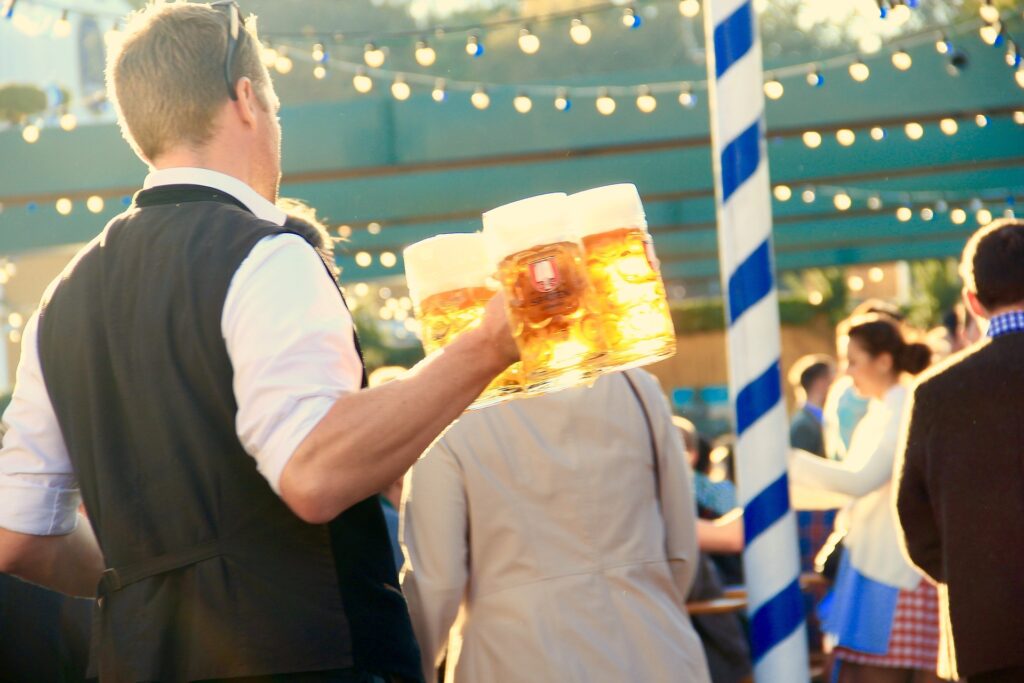
A bit of history
The first Oktoberfest was held in 1810 as part of the wedding celebrations between Crown Prince Ludwig of Bavaria and Princess Therese on October 12, 1810. The festival site at the time was located outside the city.
Oktoberfest was canceled in 1813 because of the Napoleonic wars, but resumed 1814 with several new features: climbing trees, bowling alleys, and swings were added to the horse-racing track, and in 1818 the first merry-go-round was set up.
In 1850, a statue of Bavaria was erected, towering over the festival grounds. Bavaria (Latinized term for Bavaria) is the symbolic female figure and secular patron saint of Bavaria and represents Mary’s secular counterpart as the religious Bavarian patron saint. She was commissioned by King Ludwig I (1786-1868) and stands in structural unity with the Hall of Fame on the edge of the slope above the Theresienwiese.
Toward the end of the 19th century, Oktoberfest increasingly became a popular festival known throughout the world and was extended in time by bringing it forward to the last days of September, which offer more beautiful days, while only the last weekend of the Wiesn falls in October.
In 1880, the sale of beer began, served in small stalls while the first large festival tent was erected in 1898.
In 1885, the outdoor areas of the festival were illuminated for the first time by electricity-a sensational phenomenon at the time-while in 1892, the first electrically operated merry-go-round was installed, followed by the first electrically lit marquees in 1901.
In 1895, a folk costume procession organized by Munich writer Maximilian Schmidt took place at Oktoberfest, which was the culmination of a three-day “Historisch-Bayerischen Volkstrachten-Festes” (Bavarian Historical Folk Costume Festival). Today the procession in traditional costume takes place on the first Sunday of the Wiesn.
In 1910, the Wiesn celebrated its 100th birthday.
From 1914 to 1918, the festival was canceled due to World War I, while in 1923 and 1924 it was not held due to extremely high inflation.
During the National Socialist era, the Nazi movement inserted itself into Oktoberfest and Jews were banned from working at the event. In 1938, the year Hitler had annexed Austria and won decisively over the Sudetenland issue (mountain system on the border between Germany, Poland and the Czech Republic), Oktoberfest was renamed the “Great German People’s Festival” and the Nazi regime transported large numbers of Sudeten Germans to the festival sites.
During World War II, from 1939 to 1945, no festival was held while after the war, from 1946 to 1948, an “autumn festival” was held. It was not until 1949 that Oktoberfest returned to its traditional name and celebrations.
Over the following decades, Oktoberfest has developed into the largest public festival in the world attracting millions of visitors each year with more and more guests coming from abroad, especially from Italy, the United States, Japan and Australia. Italian police officers from Bolzano have been on site since 2005 because of the large influx of Italian visitors. For some years now, the trend toward traditional costume has been established: many visitors to the Wiesn show up in lederhosen or dirndl.
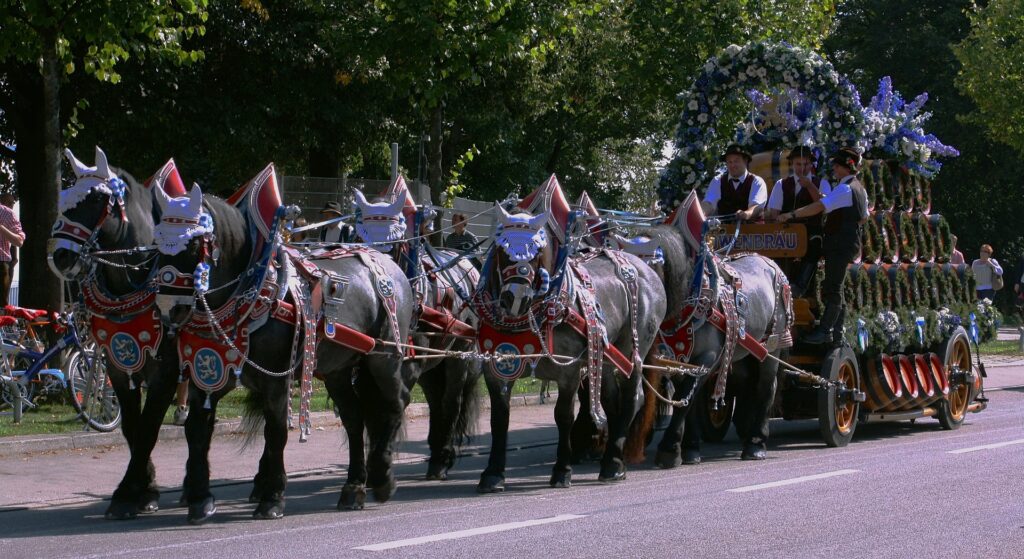
Opening Ceremony.
The opening ceremony is held on Saturday in mid-September with a procession of brewery owners (Wiesn-Einzug der Festwirte und Brauereien) in traditional dress. At 12 noon, the acting mayor of Munich officially opens the festival by uttering the famous O’Zapft is (It is uncorked) by symbolically uncorking the first barrel with a hammer. The ceremony is held at the Schottenhamel tent, and beer can only be served from this time on.
August 15 holiday with different traditions
Tents and attractions
At Oktoberfest, there are 38 marquees where only beer from Munich’s traditional breweries is served. In the Kuffler wine tent, on the other hand, only wheat beer is served. The beer mugs used are made of glass, owned by the respective breweries.
There are about 200 attractions at Oktoberfest including about 80 rides.
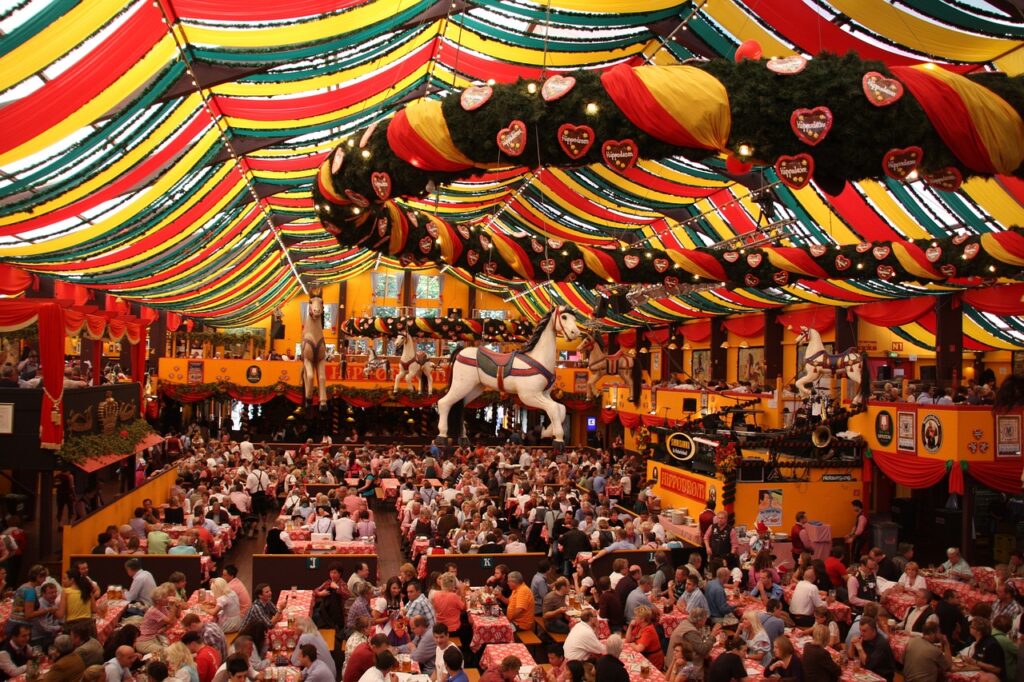
Security
Public safety is taken seriously during the event, and since the 1960s, every morning all buildings are checked by state police dogs sniffing for explosives.
After the 1980 bombing, the main entrance to the Wiesn was redesigned and numerous access controls are carried out. In the 2010 Jubilee year, 52 two-meter-high concrete Litfass columns were erected on the access roads and entrances to the Festwiese as part of the expanded security concept to prevent a scenario in which assassins might attempt to drive explosives-laden vehicles on the Theresienwiese. Since 2016, a general ban on carrying backpacks and bags and a two-meter high security fence around the festival area has been imposed due to the increased risk of terrorism, and nearly twice as many stewards have been deployed as in previous years.
Technical incidents are rare in Oktoberfest history, and rides are intensively tested in advance.
In 2004, the Behördenhof near Bavariaring was established, where police, the Munich professional fire brigade, the ambulance service under the direction of the Aicher Ambulanz Union, and the district administrative department are stationed. Because of the large number of Italian visitors, officers from the Italian police force in Bolzano have been stationed at the site since 2005.
A general ban on dogs and animals has been in place since 2010 as a “general safety measure,” and a ban on glass bottles was imposed in 2012 due to increased cutting.
The safety concept has been adapted several times over the decades.
Oide Wiesn
To celebrate the 200th anniversary, a historic Oktoberfest “Oide Wiesn” was organized for the first time in 2010 at the southern end of the Theresienwiese. Historic rides, tents, and other historic attractions such as the “Steckerlfischbraterei,” a chain carousel, or a cotton candy stand were presented on the five-hectare fenced area. Besides the museum tent, it was also possible to visit, the animal tent and the hippodrome.
In later years, the traditional Oktoberfest continued to exist under the name “Oide Wiesn” but in a reduced form, for example, the hippodrome was eliminated.
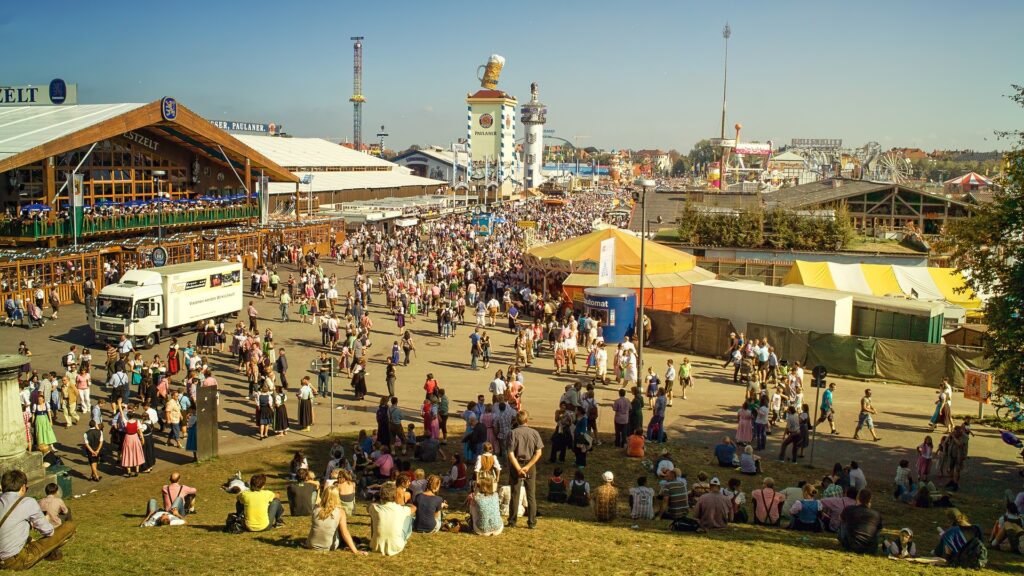
Closing Ceremony
At 12 noon, under the Bavarian statue, the Oktoberfest (Böllerschießen) salute is held with gunfire and the beer mugs are raised for the last time.
At the Wiesn-Kehraus when the band plays for the last time after closing time on the last day of the festival, a sea of sparks lights up the beer tents.
Curiosities
Albert Einstein is said to have helped set up the Wiesn in 1896(according to another source in 1886 in the family electrical company “Elektrotechnische Fabrik J. Einstein & Cie” but, despite intensive research, no evidence of this has been found.
Experienced bartenders take on average only one and a half seconds to fill a “Maßkrug” (mug).
One attraction not found at other folk festivals is the flea circus. It has been at the Wiesn since 1948 and a “troupe” of about 60 fleas entertains mainly children.
As of August 31, 2021, the term “Oktoberfest” is protected as a trademark by the European Union Intellectual Property Office (EUIPO).
Austro-American actor and former governor of California Arnold Schwarzenegger used to attend all editions of Oktoberfest.
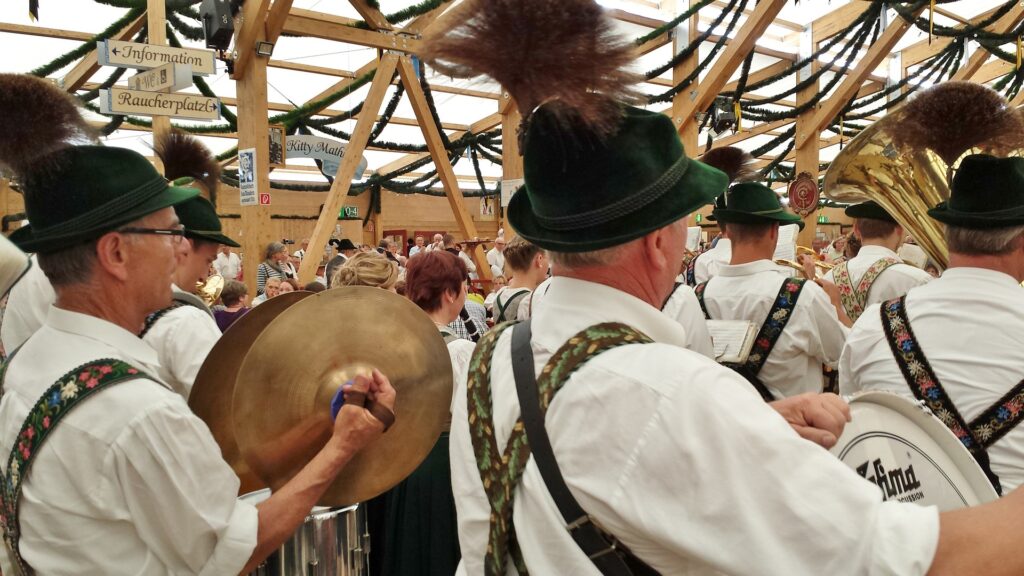
Oktoberfest in the world
A number of “Oktoberfests” inspired by this one in Munich have sprung up around the world, originating mainly from German immigrants.
In Germany there are several regional variants of Oktoberfest including the Oktoberfest in Hanover, considered the largest in Germany.
In the United States, Cincinnati, Ohio, celebrates Oktoberfest Zinzinnati every year, where residents have been commemorating their German ancestors since 1976 by naming the festival after the German pronunciation.
In Argentina there is the “Fiesta Nacional de la Cerveza,” which has been held since 1963 in Córdoba.
There are several Oktoberfests in Brazil, most of them in cities colonized by Germans and Austrians, such as the Oktoberfest in Blumenau (one of the largest German festivals in the world, attracting about a million people each year), the Itapiranga Oktoberfest, the Igrejinha Oktoberfest, the Santa Cruz do Sul Oktoberfest, the Rolândia Oktoberfest, the São Jorge d’Oeste Oktoberfest, the Ponta Grossa Oktoberfest, and the Marechal Cândido Rondon Oktoberfest.
In Canada in Kitchener, Ontario, the largest Oktoberfest in the country is held. The area has a long history of German roots and in the past Kitchener was called Berlin.
China has also celebrated Oktoberfest since 1991, and the festival in Qingdao turns out to be the largest in the country, attended by about 4 million people.
In Australia, the largest Oktoberfest takes place in Brisbane, with a huge beer tent featuring German craft beers, wines and a wide range of German dishes, as well as various entertainment programs related to German culture and traditions.
In Ireland, the Bavarian Oktoberfest is very popular, and in Dublin a big event was held every year at George’s Dock. In 2023, for the first time ever, Ireland will host an Irish version of this festival, which will be called Oktoberfeis. It is a Gaelic version of Oktoberfest, promising an unforgettable celebration infused with Irish music, food and culture.
Switzerland, Bavaria’s neighbor, also holds several Oktoberfests. The first Swiss Oktoberfest was held on the Bauschänzli in Zurich where the event still takes place today and admission is free. The most important events are the Lozärner Oktoberfest in Lucerne, the Calanda Oktoberfest in Chur, Oktoberfest Züri Oberland in Uster (ZH), and Oktoberfest Ennetbürgen (NW), where, however, reservations and payment for admission are often required.
In Romania, Oktoberfest is held in Brasov (Kronstadt in German), Transylvania, and traditional German and Romanian beers, food, and music can be found.
Several Oktoberfests take place in Italy in the wake of the Bavarian festival, but Oktoberfest in Genoa turns out to be the largest festival in Italy. The first event was held in 2005 following the opening of the renowned Hofbräuhaus brewery, which, every year organizes the event in cooperation with the municipality and the city of Genoa. Over the years this festival has grown and is the only event officially recognized by the Bavarian authorities.
In Spain Oktoberfest is celebrated in several cities. In Madrid we find the Oktoberfest Experience at the Gran Teatro CaixaBank Príncipe Pío with a menu of beer and German gastronomy while at the Palacio de los Deportes (WiZink Center) we celebrate this festival starring Lowenbraü’s Spaten OktoberfestBier, one of the six official Munich Oktoberfest breweries. In Barcelona it is celebrated in Plaza Universo of Fira Barcelona Montjuïc while in Valencia we find a Biergarten and a traditional beer garden.
In Japan, Odaiba’s Oktoberfest in Tokyo takes place at Symbol Promenade Koene and you can find different beer and sausage offerings with some of Germany’s most famous beers. In Yokohama, at the historic Red Brick Warehouse (Akarenga Soko) Oktoberfest is an autumn tradition.






